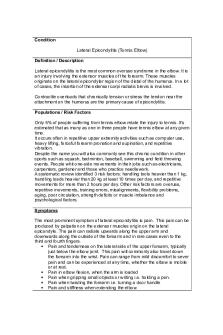Subacromial impingement syndrome clinical pattern PDF

| Title | Subacromial impingement syndrome clinical pattern |
|---|---|
| Author | lottie elliott |
| Course | Essentials of Musculoskeletal Physiotherapy |
| Institution | University of the West of England |
| Pages | 3 |
| File Size | 157.9 KB |
| File Type | |
| Total Downloads | 701 |
| Total Views | 898 |
Summary
ConditionSubacromial/shoulder impingement syndrome.Definition / DescriptionThis is a syndrome that occurswhen the arm is raised toabove shoulder height and thespace between the acromionand the rotator cuff narrowsthe acromion then can rubagainst the tendon and thebursa causing irritation andpain.Pop...
Description
Condition Subacromial/shoulder impingement syndrome. Definition / Description This is a syndrome that occurs when the arm is raised to above shoulder height and the space between the acromion and the rotator cuff narrows the acromion then can rub against the tendon and the bursa causing irritation and pain. Populations / Risk Factors
Common in athletes of all ages when doing lots of overhead or reaching movements. Sometimes the pain radiates down the upper arm. Individuals at highest risk for shoulder impingement are laborers and those working in jobs that require repetitive overhead activity. Athletes (eg, swimming, throwing sports, tennis, volleyball)
Symptoms - (Distribution, description, daily pattern, etc) Pain in the upper arm. Decreased range of movement and weakness with difficulty raising the arm over the head or behind the back. Pain at night Sudden pain with reaching and lifting movements.
Clinical Signs - (Reliable measures) Palpation: feeling around the area for when the pain occurs. X rays can show bony spurs around the area where the impingement would occur. MRI scans can show soft tissues allowing you to be able to see when there is an impingement.
History
Onset: Sudden onset of sharp pain in the shoulder with tearing sensation is suggestive of a rotator cuff tear. Gradual increase in shoulder pain with overhead activities is suggestive of an impingement problem. Chronicity of symptoms Location: Pain usually is reported over the lateral, superior, anterior shoulder; occasionally refers to the deltoid region. Posterior shoulder capsule pain usually is consistent with anterior instability, causing posterior tightness. Setting during which symptoms arise (eg, pain during sleep, in various sleeping positions, at night, with activity, types of activities, while resting) Quality of pain (eg, sharp, dull, radiating, throbbing, burning, constant, intermittent, occasional)
Quantity of pain (on a scale of 0-10, 10 being the worst) Alleviating factors (eg, change of position, medication, rest) Aggravating factors (eg, change of position, medication, increase in practice, increase in play, change in athletic gear/foot wear, change in position played) Functional symptoms - Patient changed mechanics (eg, throwing motion, swim stroke) to compensate for pain Associated manifestations (eg, possibly chest pain, dizziness, abdominal pain, shortness of breath) Provocative position: Pain with humerus in forward-flexed and internally rotated position suggests rotator cuff impingement. Pain with humerus in abducted and externally rotated position suggests anterior glenohumeral instability and laxity. Taking any medications? Previous injuries in similar location?
Investigations - (Radiology, haematoloty etc) X rays. MRI scans.
Atypical Presentations •Acromioclavicular Joint Injury •Bicipital Tendonitis •Brachial Plexus Injury •Cervical Disc Injuries •Cervical Discogenic Pain Syndrome •Cervical Radiculopathy •Cervical Spine Sprain/Strain Injuries •Clavicular Injuries •Contusions •Infraspinatus Syndrome •Myofascial Pain in Athletes •Rotator Cuff Injury •Shoulder Dislocation •Superior Labrum Lesions •Supraspinatus Tendonitis •Swimmer's Shoulder •Thoracic Disc Injuries •Thoracic Discogenic Pain Syndrome •Thoracic Outlet Syndrome
Management Options and Levels of Evidence Nsaid’s such as ibuprofen and naproxen reduce pain and swelling. Stretching exercises can help to relieve pain and once the pain has subsided the therapist can start strengthening the rotator cuff muscles. A steroid injection into the bursa underneath the acromion can relieve pain. Surgery can also treat this condition by either removing the inflamed portion of the
bursa or removing part of the acromion to allow more space in the subacromion space for the rotator cuff muscle tendons. Observe Palpate ROM Special tests Strength muscle Neuro assesment Test for instability
Useful Resources...
Similar Free PDFs

Clinical Pattern sheet
- 10 Pages

Medial meniscus clinical pattern
- 3 Pages

COPD - clinical pattern sheets
- 2 Pages

Pattern Comportamentali
- 23 Pages

CUSHING SYNDROME
- 36 Pages

Syndrome Myelodysplasique
- 3 Pages
Popular Institutions
- Tinajero National High School - Annex
- Politeknik Caltex Riau
- Yokohama City University
- SGT University
- University of Al-Qadisiyah
- Divine Word College of Vigan
- Techniek College Rotterdam
- Universidade de Santiago
- Universiti Teknologi MARA Cawangan Johor Kampus Pasir Gudang
- Poltekkes Kemenkes Yogyakarta
- Baguio City National High School
- Colegio san marcos
- preparatoria uno
- Centro de Bachillerato Tecnológico Industrial y de Servicios No. 107
- Dalian Maritime University
- Quang Trung Secondary School
- Colegio Tecnológico en Informática
- Corporación Regional de Educación Superior
- Grupo CEDVA
- Dar Al Uloom University
- Centro de Estudios Preuniversitarios de la Universidad Nacional de Ingeniería
- 上智大学
- Aakash International School, Nuna Majara
- San Felipe Neri Catholic School
- Kang Chiao International School - New Taipei City
- Misamis Occidental National High School
- Institución Educativa Escuela Normal Juan Ladrilleros
- Kolehiyo ng Pantukan
- Batanes State College
- Instituto Continental
- Sekolah Menengah Kejuruan Kesehatan Kaltara (Tarakan)
- Colegio de La Inmaculada Concepcion - Cebu









